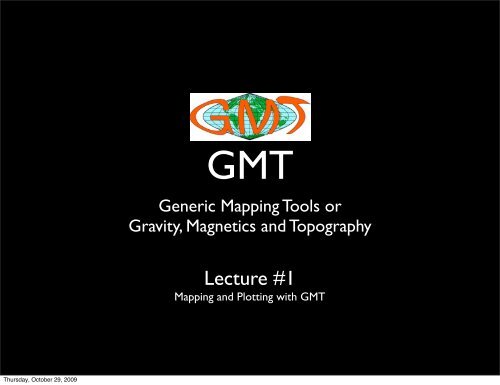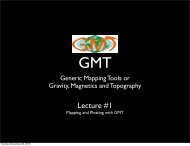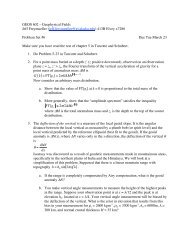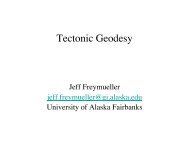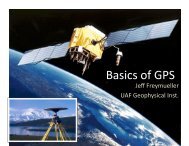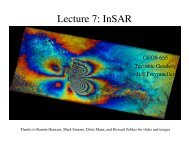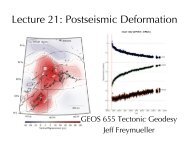GMT I, mapping and plotting
GMT I, mapping and plotting
GMT I, mapping and plotting
- No tags were found...
You also want an ePaper? Increase the reach of your titles
YUMPU automatically turns print PDFs into web optimized ePapers that Google loves.
<strong>GMT</strong>Generic Mapping Tools orGravity, Magnetics <strong>and</strong> TopographyLecture #1Mapping <strong>and</strong> Plotting with <strong>GMT</strong>Thursday, October 29, 2009
<strong>GMT</strong> 4.5.1• Began as a set of subroutines to writePostscript comm<strong>and</strong>s• Grew with Paul’s <strong>and</strong> Walter’s Ph.D. Theses• Encompassed map projections (30!)• Data Analysis• Cross-Over ErrorsPaul Wessel, our heroThursday, October 29, 2009
How does <strong>GMT</strong> work?• Scripted language for vector graphics• Facilitates automated <strong>plotting</strong>• Relates graphic space to the data space• Sequential comm<strong>and</strong>s create a plot or mapThursday, October 29, 2009
Graphic Programs• grdcontour Contouring of 2-D gridded data• grdimage Produce images from 2-D gridded datar• grdvector Plot vector fields from 2-D gridded data• grdview 3-D perspective imaging of 2-D gridded data• psbasemap Create a basemap frame• psclip Use polygon files as clipping paths• pscoast Plot coastlines, filled continents, rivers, <strong>and</strong> political borders• pscontour Direct contouring or imaging of xyz-data by triangulation• pshistogram Plot a histogram• psimage Plot Sun rasterfiles on a map• pslegend Plot legend on a map• psmask Create overlay to mask specified regions of a map• psrose Plot sector or rose diagrams• psscale Plot grayscale or colorscale• pstext Plot textstrings• pswiggle Draw anomalies along track• psxy Plot symbols, polygons, <strong>and</strong> lines in 2-D• psxyz Plot symbols, polygons, <strong>and</strong> lines in 3-DThursday, October 29, 2009
Create a simple plotpscoast -Jc190/68/0.50 -R180/225/50/72 -Di -N1 -G125 -Bg5a10 > Alaska.psThursday, October 29, 2009
The 17 st<strong>and</strong>ardized <strong>GMT</strong> comm<strong>and</strong> line switches-B Defines tickmarks, annotations, <strong>and</strong> labels for basemaps <strong>and</strong> axes-H Specifies that input/output tables have header record(s)-J Selects a map projection or coordinate transformation-K Allows more plot code to be appended to this plot later-O Allows this plot code to be appended to an existing plot-P Selects Portrait plot orientation [Default is l<strong>and</strong>scape]-R Defines the extent of the map/plot region-U Plots a time-stamp, by default in the lower left corner of page-V Selects verbose operation; reporting on progress-X Sets the x-coordinate for the plot origin on the page-Y Sets the y-coordinate for the plot origin on the page-b Selects binary input <strong>and</strong>/or output-c Specifies the number of plot copies-f Specifies the data format on a per column basis-g Identify data gaps based on supplied criteria-m Specifies data in multiple segment format-: Assumes input geographic data are (lat,lon) <strong>and</strong> not (lon,lat)Thursday, October 29, 2009
Comm<strong>and</strong> line on 1st plotpscoast -Jc190/68/0.50 -R180/225/50/72 -Di -N1 -G125 -Bg5a10 > test.ps-Jc specifies the Cassini projection, centered at 190longitude, 68 latitude <strong>and</strong> scale at 0.50 inches per map unit-R defines the map area in WESN form-Di says to use the intermediate resolution coastline-N1 says to plot international boundaries-G says to fill the continents with a medium gray-Bg5a10 says to put a grid on the map at every 5 map units <strong>and</strong> annotate itevery 10 map unitsThursday, October 29, 2009
It looks easy, but...-B Sets map boundary annotation <strong>and</strong> tickmark intervals. The format of tickinfo is [p|s]xinfo[/yinfo[/zinfo]][:."Title":][W|w][E|e][S|s][N|n][Z|z[+]]. The leading p [Default] or s selects the primary or secondary annotation information. Each ofthe ?info segments are textstrings of the form info[:"Axis label":][:="prefix":][:,"unit label":]. The info string is made upof one or more concatenated substrings of the form [which]stride[+-phase][u]. The optional which can be either a forannotation tick spacing [Default], f for frame tick spacing, <strong>and</strong> g for gridline spacing. If frame interval is not set, it isassumed to be the same as annotation interval. stride is the desired stride interval. The optional phase shifts the annotationinterval by that amount. The optional u indicates the unit of the stride <strong>and</strong> can be any of Y (year, plot with 4 digits), y (year,plot with 2 digits), O (month, plot using PLOT_DATE_FORMAT), o (month, plot with 2 digits), U (ISO week, plot usingPLOT_DATE_FORMAT), u (ISO week, plot using 2 digits), r (Gregorian week, 7-day stride from start of weekTIME_WEEK_START), K (ISO weekday, plot name of day), D (date, plot using PLOT_DATE_FORMAT), d (day, plotday of month 0-31 or year 1-366, via PLOT_DATE_FORMAT), R (day, same as d, aligned with TIME_WEEK_START),H (hour, plot using PLOT_CLOCK_FORMAT), h (hour, plot with 2 digits), M (minute, plot usingPLOT_CLOCK_FORMAT), m (minute, plot with 2 digits), C (second, plot using PLOT_CLOCK_FORMAT), c (second,plot with 2 digits). Note for geographic axes m <strong>and</strong> c instead mean arc minutes <strong>and</strong> arc seconds. All entities that arelanguage-specific are under control by TIME_LANGUAGE. To specify separate x <strong>and</strong> y ticks, separate the substrings thatapply to the x <strong>and</strong> y axes with a slash [/] (If a 3-D basemap is selected with −E <strong>and</strong> −Jz, a third substring pertaining to thevertical axis may be appended.) For linear/log/power projections (−Jx|X): Labels for each axis can be added bysurrounding them with colons (:). If the first character in the label is a period, then the label is used as plot title; if it is acomma (,) then the label is appended to each annotation; if it is an equal sign (=) the the prefix is prepended to eachannotation (start label/prefix with - to avoid space between annotation <strong>and</strong> item); else it is the axis label. If the labelconsists of more than one word, enclose the entire label in double quotes (e.g., :"my label":). If you need to use a colon (:)as part of your label you must specify it using its octal code (\072).By default, all 4 boundaries are plotted (referred to asW, E, S, N). To change the default, append the code for only those axes you want (e.g., WS for st<strong>and</strong>ard lower-left x- <strong>and</strong> y-axis system). Upper case (e.g., W) means draw axis/tickmarks AND annotate it, whereas lower case (e.g., w) will only drawaxis/tickmarks. (If a 3-D basemap is selected with −E <strong>and</strong> −Jz, append Z or z to control the appearance of the vertical axis.Append + to draw the outline of the cube defined by −R. Note that for 3-D views the title, if given, will be suppressed.)For non-geographical projections: Give negative scale (in −Jx) or axis length (in −JX) to change the direction of increasingcoordinates (i.e., to make the y-axis positive down). For log10 axes: Annotations can be specified in one of three ways: (1)stride can be 1, 2, 3, or -n. Annotations will then occur at 1, 1−2−5, or 1−2−3−4−...−9, respectively; for -n we annotate everyn’t magnitude. This option can also be used for the frame <strong>and</strong> grid intervals. (2) An l is appended to the tickinfo string.Then, log10 of the tick value is plotted at every integer log10 value. (3) A p is appended to the tickinfo string. Then,annotations appear as 10 raised to log10 of the tick value. For power axes: Annotations can be specified in one of two ways:(1) stride sets the regular annotation interval. (2) A p is appended to the tickinfo string. Then, the annotation interval isexpected to be in transformed units, but the annotation value will be plotted as untransformed units. E.g., if stride = 1 <strong>and</strong>power = 0.5 (i.e., sqrt), then equidistant annotations labeled 1−4−9... will appear.These <strong>GMT</strong> parameters can affect the appearance of the map boundary: ANNOT_MIN_ANGLE,ANNOT_MIN_SPACING, ANNOT_FONT_PRIMARY, ANNOT_FONT_SECONDARY,ANNOT_FONT_SIZE_PRIMARY, ANNOT_FONT_SIZE_SECONDARY, ANNOT_OFFSET_PRIMARY,ANNOT_OFFSET_SECONDARY, BASEMAP_AXES, BASEMAP_FRAME_RGB, BASEMAP_TYPE,DEGREE_FORMAT, FRAME_PEN, FRAME_WIDTH, GRID_CROSS_SIZE_PRIMARY, GRID_PEN_PRIMARY,GRID_CROSS_SIZE_SECONDARY, GRID_PEN_SECONDARY, HEADER_FONT, HEADER_FONT_SIZE,LABEL_FONT, LABEL_FONT_SIZE, LINE_STEP, OBLIQUE_ANNOTATION, PLOT_CLOCK_FORMAT,PLOT_DATE_FORMAT, TIME_FORMAT_PRIMARY, TIME_FORMAT_SECONDARY, TIME_LANGUAGE,TIME_WEEK_START, TICK_LENGTH, TICK_PEN, <strong>and</strong> Y_AXIS_TYPE; see the gmtdefaults man page for details.Thursday, October 29, 2009
gmtdefaultsgmtset `cat $workingdir/gmt.plot.parameters` D_FORMAT %.0f MEASURE_UNIT inchgmtset D_FORMAT %.6fUSE gmtdefaults -D to see default settingsUSE gmtdefaults -L to see your current settingsThursday, October 29, 2009
Try it again with a scriptcreate with text editor“chmod +x” to make it executable#!/bin/csh# plot a Cassini projected map of Alaska with a user-defined scaleset workingdir = `pwd`gmtset `cat $workingdir/gmt.plot.parameters`set scale = $1set w_lon = 180set e_lon = 225set s_lat = 50set n_lat = 72set map_box = -R$w_lon/$e_lon/$s_lat/$n_latset filename = alaska.psset pro_lon = `echo $w_lon $e_lon | awk '{printf"%.2f",($1+$2)/2.0}'`set pro_lat = `echo $n_lat $s_lat | awk '{printf"%.2f",($1+$2)/2.0}'`set map_pro = -Jc$pro_lon/$pro_lat/$scaleThursday, October 29, 2009
the comm<strong>and</strong>spsbasemap $map_pro $map_box -Bg5a10 -K -P > $filenamepscoast $map_pro $map_box -Di -N1 -G125/255/125 -O >>$filenameThursday, October 29, 2009
Thursday, October 29, 2009the map.....
sequence is importantpscoast $map_pro $map_box -Di -N1 -G125/255/125 -K -P > $filenamepsbasemap $map_pro $map_box -Bg5a10 -O >> $filenameThursday, October 29, 2009
Thursday, October 29, 2009a somewhat different map
add some data points?pscoast $map_pro $map_box -Di -N1 -G125/255/125 -K -P > $filenamepsxy $map_pro $map_box -Sc0.25 -G255/125/125 -K -O >> $filename > $filenameThursday, October 29, 2009
Thursday, October 29, 2009map with data points
Thursday, October 29, 2009so where did we go?
what are -K <strong>and</strong> -O?-O suppresses the header, which defines a numberof aliases to make a more compact file%!PS-Adobe-3.0%%BoundingBox: 0 0 595 842%%Title: <strong>GMT</strong> v4.2.0 Document from pscoast%%Creator: <strong>GMT</strong>%%For: bernardcoakley%%DocumentNeededResources: font Helvetica%%CreationDate: Thu Oct 29 06:47:11 2009%%LanguageLevel: 1%%DocumentData: Clean7Bit%%Orientation: Portrait%%Pages: 1%%EndComments%%BeginProlog250 dict begin/A /setgray load def/B /setdash load def/C /setrgbcolor load def/D /rlineto load def/E {dup stringwidth pop} bind def/F /fill load defThursday, October 29, 2009
-K suppresses the trailera lot of text Postscript precedes these last few lines;1 0 DS%%PageTrailerS -0 -0 T 4.16667 4.16667 scale 0 Ashowpage%%Trailerend%%EOFThe simplest state uses neither -K or -O <strong>and</strong> resultsin a complete plot with both header <strong>and</strong> trailer.By using -K <strong>and</strong> -O we can use <strong>GMT</strong> comm<strong>and</strong>s in seriesto create a single plot.Thursday, October 29, 2009
most common errors in <strong>GMT</strong> scripts• misuse of -K <strong>and</strong> -O options• using “>” instead of “>>” as a redirect• not specifying -R or -J correctly• incorrect sequencing of comm<strong>and</strong>s• trying to plot incorrectly scaled data• trying the write the whole script at onceThursday, October 29, 2009
Thursday, October 29, 2009USCGC Ship track
Thursday, October 29, 2009Gravity data from USCGC Healy
Thursday, October 29, 2009
Thursday, October 29, 2009some people are really good at this...
Assignment -Write a script to plot some data on a map.Write a 2nd script to do an x, y plot of the same data.suggestion - use awk to scale or select column data for your plotsNext time, data analysis<strong>and</strong> gridding, a lot of gridding with <strong>GMT</strong>Thursday, October 29, 2009


